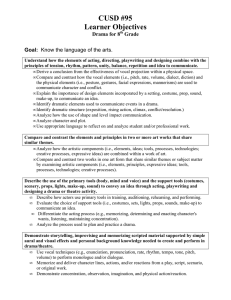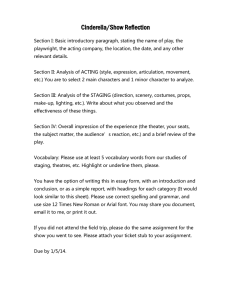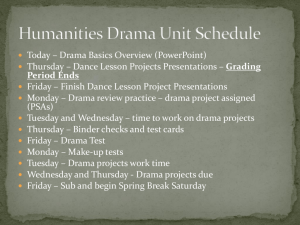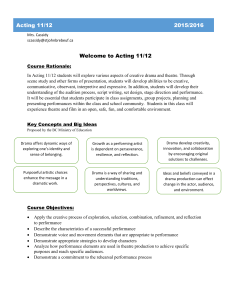CUSD #95 Learner Objectives Drama for 7 Grade
advertisement
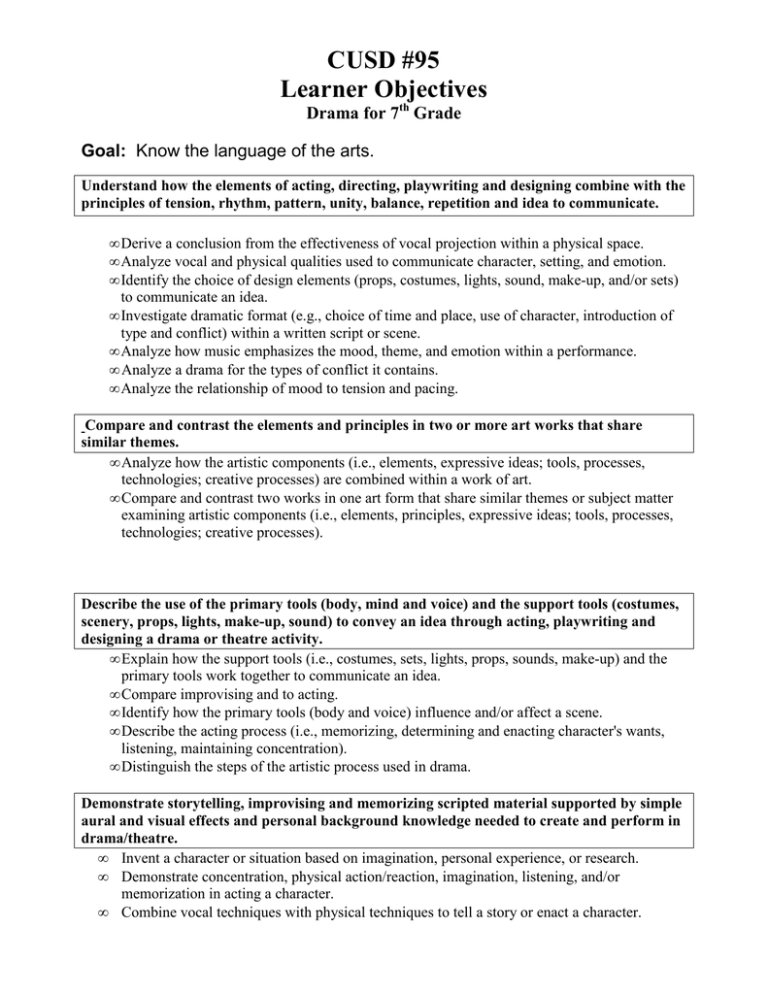
CUSD #95 Learner Objectives Drama for 7th Grade Goal: Know the language of the arts. Understand how the elements of acting, directing, playwriting and designing combine with the principles of tension, rhythm, pattern, unity, balance, repetition and idea to communicate. • Derive a conclusion from the effectiveness of vocal projection within a physical space. • Analyze vocal and physical qualities used to communicate character, setting, and emotion. • Identify the choice of design elements (props, costumes, lights, sound, make-up, and/or sets) to communicate an idea. • Investigate dramatic format (e.g., choice of time and place, use of character, introduction of type and conflict) within a written script or scene. • Analyze how music emphasizes the mood, theme, and emotion within a performance. • Analyze a drama for the types of conflict it contains. • Analyze the relationship of mood to tension and pacing. Compare and contrast the elements and principles in two or more art works that share similar themes. • Analyze how the artistic components (i.e., elements, expressive ideas; tools, processes, technologies; creative processes) are combined within a work of art. • Compare and contrast two works in one art form that share similar themes or subject matter examining artistic components (i.e., elements, principles, expressive ideas; tools, processes, technologies; creative processes). Describe the use of the primary tools (body, mind and voice) and the support tools (costumes, scenery, props, lights, make-up, sound) to convey an idea through acting, playwriting and designing a drama or theatre activity. • Explain how the support tools (i.e., costumes, sets, lights, props, sounds, make-up) and the primary tools work together to communicate an idea. • Compare improvising and to acting. • Identify how the primary tools (body and voice) influence and/or affect a scene. • Describe the acting process (i.e., memorizing, determining and enacting character's wants, listening, maintaining concentration). • Distinguish the steps of the artistic process used in drama. Demonstrate storytelling, improvising and memorizing scripted material supported by simple aural and visual effects and personal background knowledge needed to create and perform in drama/theatre. • Invent a character or situation based on imagination, personal experience, or research. • Demonstrate concentration, physical action/reaction, imagination, listening, and/or memorization in acting a character. • Combine vocal techniques with physical techniques to tell a story or enact a character. CUSD #95 Learner Objectives Drama for 7th Grade • Plan, design, alter a space, prop, costume, and/or sound source to communicate idea. Analyze how the arts function in history, society and everyday life. • Demonstrate good audience behavior and evaluate the behavior of self and others. • Describe how audience behavior changes a product of performance. • Investigate occupations that are related to the arts industry (i.e. record producers, museum lecturers, gallery owners, box office administrators, wardrobe designers). • Explain ways technology is used in the art form. Understand how the arts shape and reflect history, society and everyday life. • Analyze how a particular art work influenced society in a given time period.
